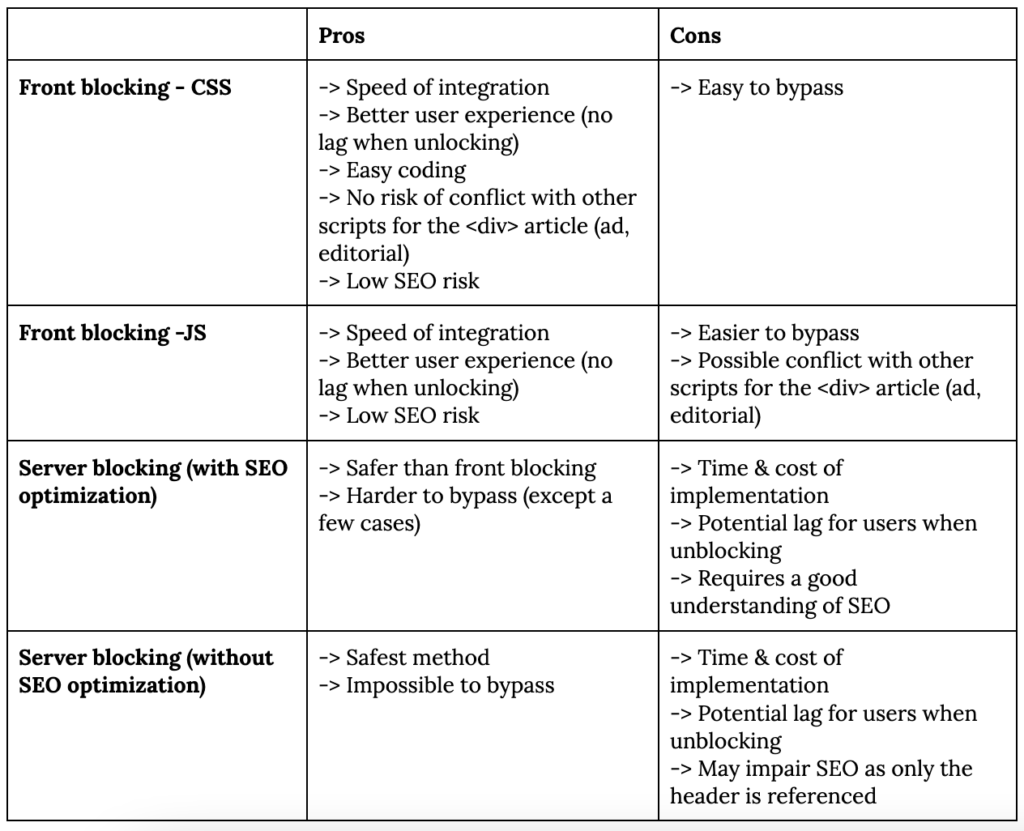

Barry Adams, independent SEO consultant, is a self-described “old dinosaur of the industry”, having started doing SEO as a hobby for his own websites in 1998 before specializing in the subject after moving to Northern Ireland and working at The Belfast Telegraph in-house, opening his eyes to SEO for news publishers. In 2016 he was approached by The Sun to help with their relaunch, which led on to other work in the industry, including with News Corp’s Fox News, Daily Mail, The Guardian, Euronews and Politico. His newsletter, SEO for Google news, is a brilliant resource for anyone working on the subject.
TL;DR: a paywall in and of itself, if implemented properly, doesn’t hurt your immediate rankings in Google’s news ecosystem. And, ultimately, everything Barry said reflects the best practices that publishers should be putting in place for their subscription model anyway. Having quality content, making sure you’re teasing with enough engaging articles, but also blocking the good stuff that gives a reader a reason to subscribe. Which suggests that SEO and subscription can work really well together.
Is the whole question of SEO very different for publishers depending on whether they have a paywall or not?
There’s quite a lot of pressure from users to mark paywalled content, because they tend not to like them, but Google seems to have very deliberately made the decision not to highlight paywalled content or penalize them in any other way – they’ve already been seen as hurting the news industry’s commercial underpinnings, and they don’t want to be seen to be hurting them anymore.
In summary, a paywall in and of itself, if implemented properly, doesn’t hurt your immediate rankings in Google’s news ecosystem.”
Do different paywall models have a different impact on SEO?
“The key is enabling Google to see beyond the paywall and get a full view of the content, subsections, links in the article, etc
Although there are 4+ types of paywall according to models in use across news sites (freemium, metered, hard, hybrid, dynamic…), Google simply differentiates between 2 sampling methods – metered and lead-in (freemium & hard).
If you have a metered model, where you give every user access to X articles per month, for Google, everytime they call an article page, it shows up as a new visit. There’s no history, no cookie associated with it, and therefore Google will always have full access to every article because it’s always seen as a first visit. So metered paywalls are generally entirely transparent for Google and publishers don’t really need to do anything more.
Freemium models are a bit different, you have to very clearly delineate your paywalled content from your free content. And with paywalled content, just like with a hard paywall model, you need to have a way for content to be viewable for Google bots.”
Javascript enabled paywalls
“There’s multiple ways of doing this – you have what’s called Javascript enabled paywalls, which basically means the paywall doesn’t kick in until the web page is loaded in the browser, including all user-side javascript. This is the technique used by The New York Times for example, as well as Conde Nast’s Wired and Vogue. With this kind of paywall, if you turn off Javascript in your browser, you can see the entire article – which most users won’t do, just the tech savvy ones. The reason for this is because Google initially crawls and indexes a news article without the JavaScript, seeing the entire article, meaning it’s an entirely transparent method.
But some publishers have a relatively weak paywall on purpose – The New York Times for instance – because they see it as a way for more people to read the content and so to help them get more subscribers, as well as the transparency of the paywall that protects SEO efforts.
Other paywall implementations have different degrees of transparency. What they call the hardest of hard paywalls, where the content is locked to all readers unless they are logged in, well Google is never logged in when it calls a website so Google also won’t see the text. In these cases, the website tends not to perform well in Google’s ecosystem because there’s a lot less content for Google to base their indexing on.”
Lead-in and title
“You should, at the very least, have a lead-in and title, otherwise Google has literally nothing to index – it might as well index an empty page and that’s never going to rank, especially not enough to compete effectively with articles where Google does have complete visibility of the whole article.
In my view, paywalls that only offer ‘lead-in’ content to Google generally perform worse than paywalls that allow Google full access to all article content.
You could also consider putting the full article text in the structured data in the HTML source code on the web page – it would still be hidden to users on the front end, but Google will be able to find it in the HTML source code. Very tech savvy users might be able to extract article content from that, but it throws up a much higher barrier for most.“
Barry wrote about this in more detail in his newsletter, SEO for Google News
“The way to do this [differentiate your paywall from an attempt at cloaking] is with your NewsArticle structured data. In the structured data snippet on your paywalled articles, you need to define the isAccessibleForFree attribute, with the value of false if the article content is (wholly or partially) behind a paywall.

Additionally, there needs to be a cssSelector attribute, which has the value of your article page’s CSS class where the paywall kicks in.
Basically, you need to show Google exactly where in your HTML the paywall begins, so that Google understands which parts of your page are freely readable and which parts require a login.”
What about other types of gates – such as registration walls or newsletter walls – do they have the same SEO impact?
“Yes. There are of course different ways of implementing the wall, and it really depends on what you want to accomplish – if you have a white paper or downloadable content that you don’t want people to access unless they’re registered then you don’t want to expose it to Google either.
In short, exposing content to Google will mean that a tech savvy user will be able to find it somehow.
But you can give an introduction, which is what many research papers have – a little abstract and introduction that encourages people to download the content but doesn’t give it away to Google.
The same with newsletters – Substack, for example, is entirely locked and doesn’t include any paywalled content in the HTML source nor the structured data. It gives the first edition or section for free, indexable for Google, and the rest is for subscribers. This acts as a lead in, allowing publishers to leave bread crumbs for their readers to engage them and hopefully encourage them to subscribe.“
What paywall blocking methods should a publisher consider? Poool’s CEO, Maxime Moné, wrote a detailed report on the impact of a paywall on SEO, including listing the 4 blocking methods and their pros and cons.

According to the report, the solution depends on your business model and strategy. If you rely heavily on advertising, your audience isn’t likely to know how to bypass paywalls, you have doubts on the impact of server-side methods of SEO and you’re just launching so want to run some tests, front blocking is likely best for you. But you may prefer server side blocking if you have a good understanding of SEO, you have a lot at stake concerning securing and content protection and your audience knows how to bypass walls. -> How can we avoid users getting around our paywall and accessing premium content without paying? What should we do if our paywall is easy to bypass? What blocking method should we use to avoid bypassing? Find the answers in this article on paywall bypassing.
What about Google News or Discover?
“It’s the same mechanism, it doesn’t really change in any way. Google’s crawling and indexing systems all build on the same algorithm and technology foundations.
The only real difference there is that for Discover, for example, it’s a recommendation engine, so Google has to know about you – it’s all about your interest signals and data.
Because of this, Google is very unlikely to show paywalled content unless you’re subscribed to it. As a non-subscriber, if you click on a paywalled content from a publisher that you’re not subscribed to, you’ll probably bounce straight back and that is a negative engagement signal for Google. It’ll then show this publisher’s content less and less because you just don’t engage with this content.”
What should you do when launching a paywall model to reduce risks to SEO?
“When you do it properly, and allow Google to have access to your content, the risks are very very low initially. You’re not going to see a loss of traffic in the short term. I would still thoroughly test it out and make sure you ask your SEO partners to guide this process along, to make sure the wall is transparent to Google, but you can be very successful with a paywall and SEO simultaneously.”
Is there a long term impact on SEO?
“There are longer term, add-on effects which do actually hurt – primarily the fact that Google still uses links said to determine a lot of quality and authority signals, and paywalled news websites tend to get a lot fewer links from other websites, simply because they’re not as easily accessible for users, not as widely read and therefore not cited as sources as often. Over time, that lack of linking will result in lower authority signals and therefore lower ranking signals for Google, hurting rankings in the long term.
However, this can be offset by the engaged, qualified users who have subscribed, so publishers may not feel the ‘pain’ in this regard.
In particular, for those news sites with a freemium model, 50-60% of news articles are freely accessible, meaning the publisher still accumulates the authority signals with Google. But the most valuable, highest quality content is behind the wall, encouraging readers to subscribe. This strategy is more commercially attractive and makes you a good citizen of the web as a news publisher – you provide some content for Google and some content for paying subscribers for better monetization.
But I will say that as a news brand if you’re going down a paywall strategy, you should look beyond SEO to how many people go directly to your brand, or type it directly into Google. Branded traffic is golden – it circumvents the whole issue of the tech monopoly.
If you don’t have a brand, you’re going to struggle to make your subscription successful. You need to provide something that people can’t find elsewhere – either by what you cover or how you cover it.
For instance, The Athletic has a paywall and covers sport. And whilst so many brands cover sport, they do it differently, that’s their sales pitch.”
Ultimately, everything Barry said reflects the best practices that publishers should be putting in place for their subscription model anyway. Having quality content, making sure you’re teasing with enough engaging articles, but also blocking the good stuff that gives a reader a reason to subscribe. Which suggests that SEO and subscription can work really well together.
“It’s become very easy to integrate a paywall that’s SEO friendly…
With the harsh economic realities of newsrooms, and the work they’re trying to do, I’m convinced that paywalls are the future. I think that, in 10-15 years, most news sites will have a paywall of some description because advertising alone is not meant to support journalism. We need engaged audiences to support journalism. And paywalls on the web for digital-only publications are the best way to do that.
And Google seems to understand this very very well, which is why they don’t want to penalize paywalls.”












